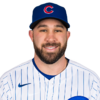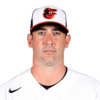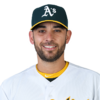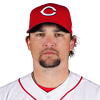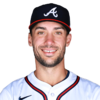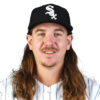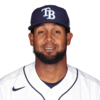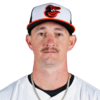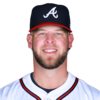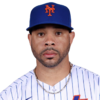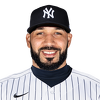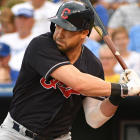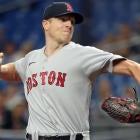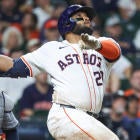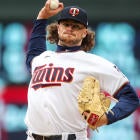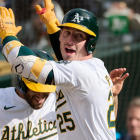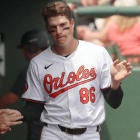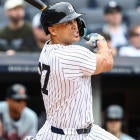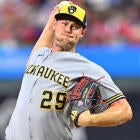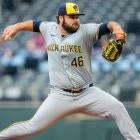- Draft Prep Tiers: C | 1B | 2B | SS | 3B | OF | SP | RP
- Heath's Sleepers | Breakouts | Busts |
- Scott's Top 100 prospects | Sleepers | Breakouts | Busts
Jan. 30 is too darn early for sleepers.
Especially this year, when the top free agents and the teams that may want them have spent the entire offseason playing chicken -- a game that drags on for many even now.
The baseball calendar forges on. We're at three weeks until go time, which means it's high time I take a second crack at this thing. Don't worry: I've retained the best and brightest from the first list, and for the ones I've removed, I've offered an explanation at the end (hint: it's not simply "because they're bad now").
But we begin with The Newcomers, the players who I've only recently decided could significantly outperform their draft position.
(Note: Some of my favorite sleepers I've reserved for Breakouts 2.0, so be sure to check out that column as well.)
The Newcomers
Christian Yelich's move to Milwaukee has gotten plenty of attention, both because he's still presumed to be an "upside guy" at age 26 and because the if-only-he-could-get-out-of-that-ballpark talk has surrounded him since the start of his career.
The start of Lorenzo Cain's career was more understated, and so we've mostly just enjoyed what he has been instead of obsessing over what he could be. But he's also escaping a cavernous park, and the splits suggest it could be just as rewarding for him. He hit 12 of his 15 home runs on the road last year, for goodness' sake.
The splits haven't been as consistent for him as for Yelich over the years, but it's a similar profile: raw power stifled by a low fly-ball rate, which means he has to make his fly balls count. Going from one of the worst home run parks to one of the best certainly raises his expected output in that category.
Enough that he'll surpass 20 for the first time? It seems like a fair expectation to me. And considering he's already one of our favorite mid-round targets for batting average and stolen bases, it'll be a fun bonus for the owner who nabs in Round 7 of a 12-team league. We're talking about an Andrew Benintendi-like profile, so he might be a bargain there even points leagues.
The eradicating of Jason Kipnis from the hearts and minds of Fantasy owners can be traced to three factors: He wasn't so good last year, he plays a position with a multitude of deserving middle-round targets (many of whom have more perceived upside), and the Indians didn't seem so invested in him when he returned from his second DL stint for a hamstring injury late last year. To further that third point, he looked like a sure bet to be traded this offseason until the front officing world decided there would be no offseason.

But now the groveling begins on the Indians' part and reawakening on all of ours. Kipnis has put together the best spring of any hitter so far, having homered six times in 20 at-bats through Wednesday's action. And yeah, small sample, inferior competition, desert air and all that, but his previous high for spring training was three home runs in 60 at-bats.
Thing is he doesn't have to morph into a superpowered version of himself to be a killer late-round pick. He's only a year removed from a 23-homer, 41-double, 15-steal season that I think we'd all take from our middle infielder. Last year may have been less about him declining (he's only 30, after all) than fighting a hamstring injury all year.
"When you are not healthy, you are spending time doing treatment and other things instead of working on your craft and hitting in the cages," Kipnis said earlier this spring. "It is nice to have that freedom and that luxury to be able to go out and train without having to worry about a specific injury."
His last season that caused us all to question his upside was 2014, and it was also marred by an injury (strained oblique). Not everyone responds to injury the same way, you know, and as well as he's responding to not having one, it's fair to wonder, particularly in light of his spring performance and comments, if some time to get healthy was all he needed.
The door is open for an elite middle-infield prospect on the most front-and-center team in baseball. You'd think he'd be getting hyped to the hills, but judging from his consensus ADP (233, according to FantasyPros), it's like Gleyber Torres is a total afterthought.
Maybe it's because so few believe he'll actually win the job this spring. He's fresh off Tommy John surgery and could probably use a little extra time to shake off the rust. Plus, promoting a top prospect for opening day isn't considered the financially prudent move.
But just like for the Braves' Ronald Acuna, we're talking only a couple weeks' wait. After all, the Yankees made a point to free up a spot for Torres this offseason, trading away both Starlin Castro and Chase Headley. And while Miguel Andujar, another prospect, factors into this equation as well, the plan calls for him to man third base and Torres second in the long run.
Of the two, Andujar is the one with more to prove, his defense forcing the Yankees to acquire Brandon Drury as a stopgap this offseason. Torres, you may remember, was on the verge of claiming the third base job himself, effectively blocking Andujar, before tearing his UCL last June. Even if he doesn't get the call at two weeks, it'll just be a matter of his bat heating up at Triple-A. The job is waiting for him.
So what's the problem? Are we doubting the upside? True, the minor-league numbers won't blow you away, but the power has been creeping up for Torres over the last two years. The progression and scouting reports remind me an awful lot of Carlos Correa, and at least for this year, Torres will still be eligible at shortstop.
Speaking in terms of impact vs. cost (and not in terms of exact production), he may well be this year's Aaron Judge, and I'm happy to devote a bench spot to him in every league.
Tanner Roark has already pulled off the same trick twice in his career. In 2014, he went 15-10 with a 2.85 ERA and 1.09 WHIP despite averaging just 6.3 strikeouts per nine innings. In 2016, he went 16-10 with a 2.83 ERA and 1.17 WHIP despite averaging just 7.4 strikeouts per nine innings.
Guess what, guys!? It's an even-numbered year!
OK, so the even-odd thing doesn't really matter to me, but what does matter is this: He has proven twice over that when everything is working mechanically, he's capable of overcoming the low-strikeout stigma, allowing such weak contact that he ends up being one of the better run-preventers in the game. There's a little Dallas Keuchel in his profile, in other words.
Judging from some of his comments this spring, he wasn't right mechanically last season, having a tendency to rock back too far on his windup which compromised his command. So this spring, he has simplified his delivery, standing sideways on the rubber instead of facing home plate.
"When you think [too much], you suck," Roark told MLB.com. "So I just go out there, you know what you need to do, and focus on the things that you need to do. Most of the time it's just the small, little things that you need to do that will fix everything else."
He made another such change down the stretch last season, loosening the grip on his two-seamer to give it more run. The result was a 3.24 ERA, 1.07 WHIP and 9.7 strikeouts per nine innings for a 12-start stretch from mid-July to mid-September. A couple of low-stakes appearances thereafter would skew the numbers, but clearly he made it part of the way back. And his spring performance would suggest the second tweak has him all the way back.
In an environment where few pitchers are allowed to throw more than six innings at a time, one who does -- and with one of the best offenses backing him -- has genuine upside and in this case twice realized upside. Surely, that's worth a 20th-round pick (or whatever 246th overall comes out to in your league).
So I'm fully willing to acknowledge Matt Harvey may be dunzo. It'd be really weird seeing as he was still cranking it up to 98 mph last season, but it's clear he just didn't have it in his first year back from thoracic outlet surgery. And once a pitcher loses it, there's no guarantee he regains it.
But let's stop and consider what "it" is in this case. I doubt it's health. Yeah, having a rib removed to relieve tension in one's throwing arm is Minority Report-style eyeball transplant scary, but other pitchers who had it in their 20s (the sample is small, but Alex Cobb and Mike Foltynewicz come to mind) rebounded just fine. And again, Harvey's velocity was almost back to normal. It was back, darn it!
So stuff, I would say, isn't the "it" in question either. More like he forgot how to get the most out of his stuff, which seems like it'd be a common hiccup during the rehabilitation process. A pitcher's mechanics are among the fussiest of baseball motions, and when the parts responsible for them are reconstructed and basic fluidity needs to be regained, precision can easily fall by the wayside. The best thing for Harvey this offseason was getting a new coaching staff's eyes in place -- a coaching staff with a celebrated pitching coach as its manager, no less.
Oh, looky what they found:
"Mechanically, It looks to me like he got into some bad habits simply because he had some injuries," pitching coach Dave Eiland told the New York Post at the start of spring training. "And he was probably doing something with his lower half to help his upper half, which is his arm, so it looks like he got into some bad habits."
Harvey's spring performance hasn't been terribly revealing one way or the other, but the reviews have been positive. Could it be nothing more than wishful thinking, making me a sucker for falling for it again? I'd say that's a likely scenario. But when the cost is my last pick, for a guy who was in the best-pitcher-in-baseball conversation just a couple years ago, I'll swallow my pride and throw those dice.
Chances are you remember Marco Estrada's 6.06 ERA over his final 22 starts last year. It's the reason you released him and vowed never to pay him another thought. But here's why you should: He had a 3.15 ERA, 1.11 WHIP and 10.2 strikeouts per nine innings over his first 11 starts, looking every bit like a Cy Young candidate the first two months of the season.
Shoot, only one of those starts was less than six innings. In today's pitching environment, he was everything you dream of, and I'll add that those first 11 starts were much more in line with his first two years in Toronto than his final 22 starts were.
So what happened? According to Sportsnet, he determined from watching some video that he was slowing down his arm on the changeup, basically telegraphing the pitch.
"I could just see my arm wasn't really getting through the zone," he said. "I was trying to baby it."
And considering it's his best pitch and the reason he has found success in the majors despite throwing in the high 80s, that's a problem.
"I kind of need that pitch," he said.
He looks like he's back on track this spring, but most Fantasy owners have moved on to younger pitchers with harder fastballs, comfortable in the belief that the 34-year-old simply lost it last year. Soft-tosser that he is, Estrada won't be losing it for a long time, and the innings he'll give you make him arguably a more worthy investment than Jordan Montgomery or Alex Reyes.
The Holdovers
The numbers above make a pretty strong case for Zack Godley on their own, and you may wonder why it is he's flying under the radar. It begins with him somehow going 8-9 for a contending Diamondbacks team. There's also the matter of him entering last season as a complete nobody, an organizational depth type who might make a spot start here and there. But that was, of course, before his transformation.
You could make the case he was underrated to begin with, as often happens for sinkerball prospects, with former Diamondbacks ace Brandon Webb being chief among them. Godley was always able to generate ground balls, and last year's rate, according to FanGraphs, would have ranked seventh among qualifying pitchers. What changed was the increased use of a curveball to generate swings and misses, and it generated them aplenty, giving him what would have been the sixth-best swinging strike rate among qualifiers, according to Baseball-Reference, ahead of Chris Archer, Carlos Carrasco, Stephen Strasburg, Luis Severino and even Clayton Kershaw.
All Godley has to do to become a big winner for a good ballclub is continue down last year's path of run prevention, which is a reasonable expectation for a pitcher with his home run-avoiding, bat-missing tendencies. His 3.41 FIP pretty much tells the story there.
In today's landscape, an out-of-nowhere pitcher with these tendencies is like manna from heaven above, and he should own it every time he steps out of a dugout. Take the mound, let his beard down and say, "In there, I am Godley, but out here ..."

And who would argue? Not me, that's for sure.
You may wonder how a guy who once finished third in AL Cy Young voting (2015) could pass as a sleeper just three years later, but remember: There was plenty of skepticism surrounding that 2015 performance, just as there was for the actual winner, Dallas Keuchel. Both he and Sonny Gray were pitchers out of their time, relying on weak contact even with strikeouts rising to unprecedented levels. And you need only a rudimentary understanding of statistics to recognize that no contact is better than some, no matter how weak.
So it wasn't the shock of the century when Gray's ERA ballooned to 5.69 the following year. In fact, judging from where he was drafted last spring, many thought he was done as a Fantasy standout. But last year, he regained some of his standing -- enough for the Yankees to give up three legit prospects for him in a deadline deal and enough for Fantasy owners to recognize that he still has value.
You may not realize how much, though.
With his resurgence, Gray continued to do the one thing he always did well: keep the ball on the ground, thereby preventing the big hit and theoretically the long ball at a time when home runs are also reaching unprecedented levels. His ground-ball rate wasn't in a different stratosphere, like Keuchel's, but it was fifth-best among qualifiers.
He also last year did the one thing he never did well, which is miss bats. I'm talking beyond just the career-high 8.5 per nine innings. His swinging strike rate, buoyed by increased slider use, was nothing short of elite, ranking 17th among qualifiers when his previous high would have ranked only 67th. For as much as his strikeout rate improved, it could have -- and perhaps should have -- been even more.
And that's just one of the stealthy ways Gray got less than he deserved in his supposed bounce-back year. An unusually homer-prone September (when his ground-ball tendencies went on hiatus) inflated his season-long rate, negating the effect of all the ground balls. He nonetheless delivered a 3.72 ERA in his 11 starts with the Yankees but still went only 4-7, leaving him with a 10-12 mark for the season.
Have you seen the Yankees roster this season? They had the second-best offense in baseball last season and then added the reigning NL MVP to it. They have five closer-caliber relievers in Aroldis Chapman, David Robertson, Dellin Betances, Tommy Kahnle and Chad Green. They're uniquely equipped -- as much as any team I can remember -- to hand a starting pitcher a lead and then preserve it for him. There's no way Gray finishes under .500 again, and I'll be shocked if he wins fewer than 15 games.
So to recap: A pitcher who stood out by so much in one area that it nearly won him a Cy Young award is now beginning to stand out in another while also finding himself with the best supporting cast in recent memory. I dare say the best is yet to come for him.
Lost in the spectacle that was Rhys Hoskins last August and September was a green-clad man doing red-blooded things, specifically homering 16 times in 23 games during one four-week stretch.
Zoom out further, and he hit 20 home runs in the span of 36 games. Zoom out further, spanning his full stay in the majors, and he hit 24 home runs in 59 games. Zoom out even further to the entire 2017 season, minors and majors included, and he hit 47 home runs in a span of 128 games.
And my heart went pitter-patter.
I'm not one of those Fantasy analysts who values players solely on the basis of how many home runs they can hit, but even in the age of the home run, that is some uncommon power. And you have little reason to doubt it. Olson consistently elevated the ball (his fly-ball rate, according to FanGraphs, would have ranked 14th if he had the at-bats to qualify), he consistently pulled the ball (his pull rate would have ranked fifth), and he consistently squared up the ball (his hard-contact rate would have ranked 17th). It's a textbook power profile for a player who also once had a 37-homer season in the minors.
What clinches it for me is that the strikeouts weren't the problem I thought they'd be. Olson's 27.8 percent rate was below-average, to be sure, but compare it to that of other prodigious sluggers like Joey Gallo, Aaron Judge or Chris Davis, and he might as well be Ichiro.
I supposed you could argue he's too homer-dependent, having just two doubles to go along with his 24 homers in the majors last year, but the guy clears fences everywhere he goes. I don't see why it'd stop now. He was on like a 70-homer pace as a rookie, which is obviously too good to be true, but what isn't? 45? 50? This side of Giancarlo Stanton and Judge, Olson might be the best bet for that lofty total.
I don't doubt people see the 27 home runs and 97 RBI that Scooter Gennett contributed last year. I suspect they're desensitized to those numbers in today's offensive environment. It's more like "well, 20 home runs aren't worth much these days, and besides, he'll never do it again."
But I think they'd be surprised to learn just how impactful those numbers were. Remember: Gennett started out as a bench player last year. On June 5, thanks in large part to sporadic playing time, he had just three of those 27 home runs. It wasn't until the next day, his historic four-homer game, that Fantasy owners took notice, and the response then was universal dismissal.
So let's just look at what he did thereafter, eliminating the historical outlier and assessing only the aftermath. From his move into the lineup June 18 through the end of the season -- a span of 87 games -- Gennett hit .298 with 20 home runs and an .886 OPS. His 3.30 Fantasy points per game during that stretch would have been the fifth-most among second basemen for the entire season, behind only Jose Altuve, Jose Ramirez, Brian Dozier and Daniel Murphy -- i.e., the ones everybody's looking to draft in the early rounds.
Needless to say, he wasn't a reserve or even a part-timer by season's end. He was the Reds' everyday second baseman, and now with shortstop freed up for Jose Peraza, he has basically no competition for the role.
And while I can't rule out the possibility that he just got lucky for 3 1/2 months and can even admit he's likely to regress some given his track record, I don't see any red flags in the batted-ball data. He simply began to hit the ball harder and higher at an age that makes sense and in a venue that rewards it.
At 190 overall, why the heck not?
I suppose I owe Danny Salazar a thank you.
Heading into 2018, my initial assessment of Mike Clevinger -- just a base assessment of the numbers -- placed him 42nd among starting pitchers, third-best among Cleveland's lot because, well, that's what he was last year.
It didn't even cross my mind that their third-best pitcher -- owner of a 3.11 ERA in 21 starts (and six relief appearances) -- wouldn't have a job to begin the year, but because Salazar and Josh Tomlin were still kicking around, it was less than a foregone conclusion
Salazar's lingering shoulder issue has since provided some clarity, but ADP has yet to catch up to the idea that Clevinger is here to stay. Or maybe Fantasy owners don't realize just how good he is.
Here's the complete list of qualifying pitchers who averaged more than his 10.1 strikeouts per nine innings last year: Chris Sale, Robbie Ray, Max Scherzer, Corey Kluber, Chris Archer, Jacob deGrom, Luis Severino, Stephen Strasburg, Clayton Kershaw, Carlos Carrasco and Jimmy Nelson.
Here's the complete list of qualifying pitches who had better than his 21.9 percent swinging strike rate, according to Baseball-Reference: Max Scherzer, Robbie Ray, Corey Kluber, Masahiro Tanaka, Chris Sale, Zack Godley, Chris Archer, Clayton Kershaw and Carlos Carrasco.
Here's his number of quality starts over his final 13: nine.
Here's to a pitcher I want on all my Fantasy teams.
Martinez hit .353 with four home runs and a .986 OPS when the Cardinals turned regular duty over to him during the season's final month, averaging about as many Fantasy points per game during that stretch as Jose Abreu did for the season. It wasn't a great departure from what he did as a part-timer. The end result was a .309 batting average and .897 OPS.
And while you may say "well, his success was built on a .350 BABIP that's obviously unsustainable," my response would be "is it?"
Martinez's 26.6 percent line-drive rate, according to FanGraphs, would have ranked fifth among all qualifiers last year, and six of the top nine had a BABIP of .340 or better. Shoot, Freddie Freeman has made a name for himself off of that kind of line-drive rate, and his career BABIP is .341. Meanwhile, only three of those nine hit the ball the opposite way as often as Martinez. One was Miguel Cabrera, whose batted-ball tendencies were suspiciously out of line with his production. The other two were Joe Mauer and DJ LeMahieu, who managed to hit over .300 despite offering considerably less power than Martinez
Looking at it that way, Martinez's batting average may have been on the low side last year, and when you consider also he struck out at a Freeman-like rate, well, the guy can hit. There's no question, He might even contend for a batting title if he got the chance.
It's just a question of opportunity.
It won't come in the outfield now that Marcell Ozuna is on board, so it has to be at first base, where the Cardinals would prefer to play Matt Carpenter. But they showed down the stretch that they're willing to move Carpenter back to third base to get Martinez's bat in the lineup. For the price of a late-round pick, I'm hoping they'll do it again.
Austin Hays wasn't known even to dynasty league owners at this time a year ago. A third-round pick in 2016, he was kind of just another guy in the Orioles system.
But numbers like he put up in 2017 will catch anyone's attention. His 32 home runs tied for second-most among minor-leaguers, and his .329 batting average, thanks to a low strikeout rate, was supported by a not-so-unreasonable .340 BABIP.
And it wasn't a case of him beating up inferior competition for half a season before coming down to earth with a move up the ladder. His numbers at high Class A and Double-A basically mirrored each other:
G | AB | HR | BA | OPS | BB | K | |
A+ | 64 | 262 | 16 | .328 | .956 | 12 | 40 |
AA | 64 | 261 | 16 | .330 | .960 | 13 | 45 |
There doesn't seem to be much skepticism surrounding the performance either. Baseball America recently named Hays its No. 21 prospect, ahead of notables Brendan Rodgers, Royce Lewis and Hunter Greene. As easily he took to those levels at age 21, he looks like a player who'll legitimately hit for both average and power, and though a shoulder issue prevented him from claiming the right field job this spring, he's looking at an early call-up with only Colby Rasmus standing in his way.
So why the lack of interest? How is Hays only 322nd in FantasyPros consensus rankings? Where's the residual Ronald Acuna love? Can't we find room in our hearts for another outfielder who's forcing his way into the lineup with some crazy minor-league numbers?
I'll take Hays for my fifth outfielder spot. I'll take it to the bank.
I'm kind of cheating by lumping two players together here, but they're in the same boat. Basically, each of Keone Kela and A.J. Minter is his team's best reliever, but neither is the closer -- not yet, anyway. And unlike in the case of Andrew Miller, the guys ahead of them aren't exactly Cody Allen.
The Rangers' Alex Claudio is a throwback to the Bob Wickman days, striking out less than a batter per inning but succeeding with a high ground-ball rate. There's a reason we don't see that type of pitcher in the closer role anymore, though. Every ball put in play offers the potential for a rally, and you just can't have that in the ninth inning.
The Braves' Arodys Vizcaino is a better fit for the role with his high-90s fastball and 10.0 strikeouts per nine innings. But his FIP (3.72) was almost a full run higher than his ERA (2.83) because of shaky control and some vulnerability to the long ball. He's probably not the long-term answer for the role either.
Kela might have been the first choice to step in for a reeling Sam Dyson early last season if a conflict with teammates over a lack of effort hadn't bumped him from the spring training roster. He came back from that messy ordeal throwing gas. His 4.2 hits per nine ranking second among relievers with at least 35 innings and his 11.9 strikeouts per nine ranking 26th. Minter, meanwhile, is as hyped as relief pitcher prospects come, the best the Braves have developed since Craig Kimbrel and a bat-misser extraordinaire. His FIP in his 15-inning stint last year was a comical 0.96.
The inevitability for these two makes them so attractive to me. Even if it doesn't happen in spring training, they will get their chance this year, and at least based on what we can measure, they will dominate.
They're especially worth drafting in leagues where you don't have to employ your entire bench, reserving a few spots for wait-and-see picks. In the case of Kela, I'm actually targeting him ahead of Claudio.
The Dropouts
In terms of overall impact, Tommy Pham was Cody Bellinger last year. You may not have noticed given that his promotion last May, just the latest of several return trips, was merely a footnote and came without the hype and hoopla of a 22-year-old making his major-league debut. He didn't get the Home Run Derby invite, he didn't get the postseason hardware, but by golly, he produced -- basically the same number of Head-to-Head points per game as Bellinger over basically the same span of time.
And he did it in a wider variety of ways, his superior contact rate giving him a plus batting average and his proclivity on the base paths making him a 20-20 man -- neither of which speaks to his most valuable contribution of all, which was reaching base at a .411 clip.
And again, he did in five months' time.
Now, some will tell you that for a 29- year-old whose previous stops in the majors made no lasting impression, these numbers are too good to be true, but they may not be accounting for the entire Pham saga, which featured an appropriate amount of hype in his teenage years, followed by a litany of injuries and eventually vision problems. Even as recently as three years ago, I saw noted prospect guru John Sickels compare his upside to Eric Davis.
The point is Pham was long a sleeping giant who just needed that final nudge to wake up. Proper management of his eye condition, called keratoconus, proved to be exactly that. The abnormal shape of Pham's corneas changes the way he processes images. He's legally blind in his left eye, according to the St. Louis Post-Dispatch. A special set of contacts uniquely mapped to take the shape of his eyes made all the difference.
The most questionable aspect of his production is the power, which came in spite of a low fly-ball rate. But then there's the stolen bases. And the walks. Not to mention the fact that his month-to-month production reveals no blips, making it, if indeed a mirage, the most perfect mirage the world has ever seen:
Pham has proven to be so good in so many ways that he could slip in one area and still produce early-round numbers.To me, it's just a matter of him staying healthy.
Reason for removal: I still love Tommy Pham and in fact find myself drafting him more often than any player in Round 5. But the reason I have to draft him in Round 5 is because he's being drafted 57th overall on average, about 25 picks earlier than he looked like he was being drafted in January. It'd be hard to justify taking more than a few picks earlier than he's going, so the "sleeper" label no longer applies.
"Well, I guess I'll be talking down Marwin Gonzalez next year."
That's what I said to myself -- alone, in the dark -- when I first started ranking players for 2018 last September. I saw the .907 OPS, the fact he would retain shortstop ability, and the reasonable strikeout rate and assumed people would go overboard for a player who's ultimately just a super-utility guy.
But now I see he's only 188th in FantasyPros consensus rankings, behind the likes of Trey Mancini, Dexter Fowler and Javier Baez, which compels me to take a different tack.
Guys, he had a .907 OPS last year, and he's shortstop-eligible!
I'm not even sure playing time is the issue I worried it'd be in September, He went on to start every one of the Astros' 18 postseasons games, and right now he's the best option they have for left field. It doesn't mean he'll be their everyday left fielder -- manager A.J. Hinch has discussed rotating his star players in the DH spot to make better use of Gonzalez's versatility -- but he'll play almost every day for as long as he deserves to.
And yes, it's fair to wonder if he'll always deserve to given his track record. And yes, his second half, while still yielding a respectable .848 OPS, confirms that he benefited from an impossibly hot start power-wise. But again, the batted-ball data mostly supports what he did, right down to the low strikeout rate (the BABIP was a little on the high side, but nothing excessive), which makes the probability of him doing it again high enough for me to target him as a top-12 shortstop and not some sideshow, especially given his quadruple ability -- a rare find at the start of the year.
Chris Taylor was just as surprising last year, had a higher strikeout rate, is lacking the shortstop eligibility and arguably has more threats to his playing time, and yet he's ranked about 80 spots higher. Go figure.
Reason for removal: As with Pham, the early data suggested Gonzalez was being drafted later -- by 100 picks, actually -- than it turns out he actually is. He's no great value at 133 overall and in fact may be a little risky with the Astros now saying they hope to find at-bats for Derek Fisher.
Just because you don't see a path to a rotation spot for Josh Hader doesn't mean it doesn't exist. I'll admit there's some crowding there for the Brewers, which was made worse by the signing of small fish Jhoulys Chacin and could be made even worse if they hook one of the big fish, as rumored.
But I'm not exaggerating when I say Hader could be better than all of them.
How good was the left-hander as a reliever last year? So good he had the eighth-lowest hit rate among pitchers with at least 45 innings, ranking up there with Craig Kimbrel (second), Dellin Betances (third) and Andrew MIller (fifth). He also had the 13th-highest strikeout rate. His walk rate held him back, but he issued just three walks over his final 17 appearances, spanning 22 1/3 innings
He's on the Chris Sale plan, learning on the job in a lower-impact role before the Brewers introduce him as their ace. It's clear from their offseason maneuvering they're not ready to do that just yet, but it won't take much -- an injury, a Zach Davies implosion, a clutch three-inning appearance in extras in which he strikes out eight -- to force the Brewers' hand
And if you'll get to enjoy his ERA and WHIP in the meantime, what's the harm in investing a late-round pick in him?
Reason for removal: The Brewers declared well before the start of spring training that Hader would work out of the bullpen again, not even bothering to stretch him out just in case, which tells me they genuinely value him more as a setup man right now. I still think he's a starter eventually -- possibly as soon as this season -- but since it doesn't appear to be a priority, there's not much sense in waiting it out.
Wait, what? Those are his minor-league stats?
What are we doing here? What's so special about J.P. Crawford? Why are you telling me he's some kind of sleeper when his numbers are making me some kind of sad?
Because those numbers don't tell the whole story.
Yeah, it was bad, but you know what was worse? Crawford's 2016 at Triple-A Lehigh Valley, when he hit .250 with a .688 OPS.
Not helping, am I? OK, but listen: Even throughout those struggles when he seemingly forgot what to do with that stick in his hands, the true prospect gurus out there -- the ones who build entire publications around their prospecting abilities -- never blinked. Heading into 2017, after that first dreadful year at Triple-A, Crawford was the No. 12 prospect for Baseball America, No. 7 for MLB.com and No. 4 for Baseball Prospectus.
See, throughout those struggles, he continued to excel at the most important skill of all: putting the bat on the ball. He struck out just 80 times in 472 at-bats at Triple-A in 2016 and 97 in 474 at-bats last year. Having already cleared that hurdle, his athleticism still had a chance to set him apart if he could just figure out what he was doing wrong.
And lo and behold, he did. Working with minor-league hitting instructor Sal Renden, he dropped his hands and moved them closer to his body, speeding up his bat to give him a .283 batting average, 13 home runs and .916 OPS in his final 59 minor-league games. It earned him a late-season callup and precipitated the Freddy Galvis trade this offseason, freeing up the shortstop job for him.
There's a real chance he's fixed now, which puts him back on the same track as Corey Seager and Francisco Lindor -- those prospects we mentioned in the same breath a few short years ago. A comparable breakthrough isn't terribly far-fetched, but because his turnaround is disguised in the season-long numbers, not to mention the worrisome two-year trend and the fact most of his major-league time came at third base last season (making him ineligible at shortstop to begin the season), he's not getting hyped as he should.
It's up to you to capitalize.
Reason for removal: It's not that anything I said about Crawford in January is inaccurate or somehow less valid. It's just that I so rarely find myself motivated to pick the guy in drafts. Other upside shortstops like Gleyber Torres and Amed Rosario are available so late even in 15-team leagues that there's no reason for me to single out this guy.









